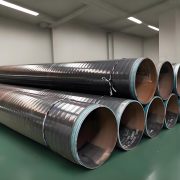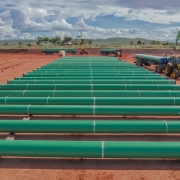3LPE vs 3LPP: Comprehensive Comparison of Pipeline Coatings
Introduction
Pipeline coatings protect steel pipelines from corrosion and other environmental factors. Among the most commonly used coatings are 3-layer Polyethylene (3LPE) and 3-layer Polypropylene (3LPP) coatings. Both coatings offer robust protection, but they differ in terms of application, composition, and performance. This blog will provide a detailed comparison between 3LPE and 3LPP coatings, focusing on five key areas: coating selection, coating composition, coating performance, construction requirements, and construction process.
1. Coating Selection
3LPE Coating:
Usage: 3LPE is widely used for onshore and offshore pipelines in the oil and gas industry. It is particularly suitable for environments where moderate temperature resistance and excellent mechanical protection are required.
Temperature Range: The 3LPE coating is typically used for pipelines operating at temperatures between -40 °C and 80 80°C.
Cost Consideration: 3LPE is generally more cost-effective than 3LPP, making it a popular choice for projects with budget constraints where the temperature requirements are within the range it supports.
3LPP Coating:
Usage: 3LPP is favored in high-temperature environments, such as deepwater offshore pipelines and pipelines transporting hot fluids. It is also used in areas where superior mechanical protection is needed.
Temperature Range: 3LPP coatings can withstand higher temperatures, typically between -20°C and 140°C, making them suitable for more demanding applications.
Cost Consideration: 3LPP coatings are more expensive due to their superior temperature resistance and mechanical properties, but they are necessary for pipelines that operate in extreme conditions.
Selection Summary: The choice between 3LPE and 3LPP primarily depends on the pipeline’s operating temperature, environmental conditions, and budget considerations. 3LPE is ideal for moderate temperatures and cost-sensitive projects, while 3LPP is preferred for high-temperature environments where enhanced mechanical protection is essential.
2. Coating Composition
3LPE Coating Composition:
Layer 1: Fusion Bonded Epoxy (FBE): The innermost layer provides excellent adhesion to the steel substrate and is the primary corrosion protection layer.
Layer 2: Copolymer Adhesive: This layer bonds the FBE layer to the polyethylene topcoat, ensuring strong adhesion and additional corrosion protection.
Layer 3: Polyethylene (PE): The outer layer provides mechanical protection against physical damage during handling, transportation, and installation.
3LPP Coating Composition:
Layer 1: Fusion Bonded Epoxy (FBE): Similar to 3LPE, the FBE layer in 3LPP serves as the primary corrosion protection and bonding layer.
Layer 2: Copolymer Adhesive: This adhesive layer bonds the FBE to the polypropylene topcoat, ensuring strong adhesion.
Layer 3: Polypropylene (PP): The outer layer of polypropylene offers superior mechanical protection and higher temperature resistance than Polyethylene.
Composition Summary: Both coatings share a similar structure, with an FBE layer, a copolymer adhesive, and an outer protective layer. However, the outer layer material differs—Polyethylene in 3LPE and polypropylene in 3LPP—leading to differences in performance characteristics.
3. Coating Performance
3LPE Coating Performance:
Temperature Resistance: 3LPE performs well in moderate temperature environments but may not be suitable for temperatures exceeding 80°C.
Mechanical Protection: The polyethylene outer layer provides excellent resistance to physical damage, making it suitable for onshore and offshore pipelines.
Corrosion Resistance: The combination of FBE and PE layers offers robust protection against corrosion, especially in humid or wet environments.
Chemical Resistance: 3LPE offers good resistance to chemicals but is less effective in environments with aggressive chemical exposure compared to 3LPP.
3LPP Coating Performance:
Temperature Resistance: 3LPP is designed to withstand temperatures up to 140°C, making it ideal for pipelines transporting hot fluids or in high-temperature environments.
Mechanical Protection: The polypropylene layer provides superior mechanical protection, especially in deepwater offshore pipelines with higher external pressures and physical stress.
Corrosion Resistance: 3LPP offers excellent corrosion protection, similar to 3LPE, but it performs better in higher-temperature environments.
Chemical Resistance: 3LPP has superior chemical resistance, making it more suitable for environments with aggressive chemicals or hydrocarbons.
Performance Summary: 3LPP outperforms 3LPE in high-temperature environments and provides better mechanical and chemical resistance. However, 3LPE is still highly effective for moderate temperatures and less aggressive environments.
4. Construction Requirements
3LPE Construction Requirements:
Surface Preparation: Proper surface preparation is crucial for the effectiveness of the 3LPE coating. The steel surface must be cleaned and roughened to achieve the necessary adhesion for the FBE layer.
Application Conditions: The 3LPE coating must be applied in a controlled environment to ensure the proper adhesion of each layer.
Thickness Specifications: The thickness of each layer is critical, with the total thickness typically ranging from 1.8 mm to 3.0 mm, depending on the pipeline’s intended use.
3LPP Construction Requirements:
Surface Preparation: Like 3LPE, surface preparation is critical. The steel must be cleaned to remove contaminants and roughened to ensure proper adhesion of the FBE layer.
Application Conditions: The application process for 3LPP is similar to that of 3LPE but often requires more precise control due to the coating’s higher temperature resistance.
Thickness Specifications: 3LPP coatings are typically thicker than 3LPE, with the total thickness ranging from 2.0 mm to 4.0 mm, depending on the specific application.
Construction Requirements Summary: 3LPE and 3LPP require meticulous surface preparation and controlled application environments. However, 3LPP coatings generally require thicker applications to enhance their protective qualities.
5. Construction Process
3LPE Construction Process:
Surface Cleaning: The steel pipe is cleaned using methods like abrasive blasting to remove rust, scale, and other contaminants.
FBE Application: The cleaned pipe is preheated, and the FBE layer is applied electrostatically, providing a solid bond to the steel.
Adhesive Layer Application: A copolymer adhesive is applied over the FBE layer, bonding the FBE to the outer polyethylene layer.
PE Layer Application: The polyethylene layer is extruded onto the pipe, providing mechanical protection and additional corrosion resistance.
Cooling and Inspection: The coated pipe is cooled, inspected for defects, and prepared for transportation.
3LPP Construction Process:
Surface Cleaning: Similar to 3LPE, the steel pipe is thoroughly cleaned to ensure proper adhesion of the coating layers.
FBE Application: The FBE layer is applied to the preheated pipe and serves as the primary corrosion protection layer.
Adhesive Layer Application: A copolymer adhesive is applied over the FBE layer, ensuring a solid bond with the polypropylene topcoat.
PP Layer Application: The polypropylene layer is applied through extrusion, providing superior mechanical and temperature resistance.
Cooling and Inspection: The pipe is cooled, inspected for defects, and prepared for deployment.
Construction Process Summary: The construction processes for 3LPE and 3LPP are similar, with different materials used for the outer protective layer. Both methods require careful control of temperature, cleanliness, and layer thickness to ensure optimal performance.
Conclusion
Choosing between 3LPE and 3LPP coatings depends on several factors, including the operating temperature, environmental conditions, mechanical stress, and budget.
3LPE is ideal for pipelines operating at moderate temperatures and where cost is a significant consideration. It provides excellent corrosion resistance and mechanical protection for most onshore and offshore applications.
3LPP, on the other hand, is the preferred choice for high-temperature environments and applications requiring superior mechanical protection. Its higher cost is justified by its enhanced performance in demanding conditions.
Understanding the specific requirements of your pipeline project is essential in selecting the appropriate coating. Both 3LPE and 3LPP have their strengths and applications, and the right choice will ensure long-term protection and durability for your pipeline infrastructure.






